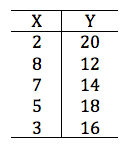|
Using SPSS for
descriptive statistics for large
datasets
Use the data set states.sav
to answer questions (1) - (4) below.
This data set contains two variables:
Percent of State Residents Living in
Poverty in 1997 (perpov)
and Percent of Votes for President
Clinton in 1996 (pervote).
(Note: These are hypothetical data.)
(1) For each
variable, report the mean, median,
and mode. Based on a comparison of
the mean, median, and mode, what is
the shape of the distribution of
each variable (choose from
symmetrical, positively skewed, or
negatively skewed)?
(2) Based on the
shape of the distributions and the
range and standard deviation of the
distributions, which one appears to
be more variable (hint: remember
that each variable is measured on
the same scale - percentage out of a
100)?
(3) Assume for
this question only that the two
distributions are normal. What is
the likelihood of finding a state
with percent poverty of 12.0% or
above? What is the likelihood of
finding a state where between 48.0%
and 52.0% of the people voted for
President Clinton in 1996?
Finding
z-scores and probabilites
The scale for the SAT is
set so that the population of scores is
approximately normal with mean = 500 and
standard deviation = 100.
(4) What is the
median SAT score?
(5) You run a
tutoring service for students who
score between 350 and 650 on the
SAT. Predict how many students you
can expect from area high schools
to use your service if 100,000
students take the SAT (hint: use
the unit normal table to find the
percentage of students this range
represents).
Be prepared to do some stuff "by
hand" (using a calculator is okay). Know
the formula for mean, standard deviation
(for both populations and samples) and
z-score. Minor calculations may be
required on the closed-book portion.
Major calculations (e.g., calculate the
standard deviation from scratch for a
set of scores) will be needed for the
open-book portion.
Consider the following sample
data.
110, 105, 120, 95, 85, 105,150
6a) What are the
mean, mode, and median of this set
of data?
6b) What is the
standard deviation of the data
(from this sample)?
6c) What is the
z-score for the 110 raw score?
Does this make sense [given the
values you calculated in (a) and
(b)]? What is the z-score for 95?
Does this make sense?
|
Plotting Scatterplots and
correlations
Consider the following set of data:

Step 1: Make a scatterplot
(7) Using SPSS make
a scatterplot of the data in the table above.
Based on your scatterplot what do you expect
that r should equal to (make an estimate).
(8) Calculate the Pearson r
statistic by hand. I have provided you
with a table to help (feel free to use a calculator).
Compute SSX, SSY, and
SP.

(9) Check your answer using
SPSS to compute the pearson correlation (r).
(note: it may be off a little due to round
off error in your by hand calculations)
COPY & PASTE
OR ATTACH YOUR Worksheet & SPSS OUTPUT
TO LAB 13 ASSIGNMENT.
Since this is a review
lab, you may check your answers HERE.
|


